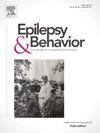三维定量运动分析在癫痫发作中动态自动运动特征的临床应用及可视化新技术
IF 2.3
3区 医学
Q2 BEHAVIORAL SCIENCES
引用次数: 0
摘要
目的:我们的目的是测试NeuroKinect 3d方法的能力,作为一种运动可视化技术和定量分析,以区分过度运动和局发性癫痫与手动自动性。该数据集提取自NeuroKinect数据集,该数据集是癫痫发作的RGB-D-IR数据集。数据集是用Kinect v2记录的,由RGB、红外(IR)和深度流组成。对20例运动癫痫进行定量3d运动分析。捕获感兴趣区域(= ROI:头部、右手、左手和躯干)的速度、加速度、抽搐、覆盖距离、位移和运动程度。结果分析的癫痫发作中,多动性发作10例(n = 7):男4例,女3例;平均年龄39.6岁(SD±9.7)),10例局灶性癫痫伴手动自动性(n = 10:男2例,女8例;平均年龄39.2岁(SD±17.6))。多动性癫痫发作在所有roi中表现出更高的平均速度(例如,头部= 0.62±0.28 (m/s) vs. 0.12±0.07 (m/s)),并且在大多数roi中表现出更高的平均加速度和平均抽搐;这些差异具有统计学意义。所有roi的平均运动范围、覆盖距离和位移在多动癫痫发作时更大,但不显著。初始运动持续时间(80 s±38 s vs 26 s±14 s;P = 0.001)的局灶性癫痫发作伴手动作自动性显著延长。结论这种新的可视化技术可以通过3D观察器重建跟踪的运动,并支持3D运动量化,能够区分以运动为特征的癫痫发作,有助于定位癫痫区。本文章由计算机程序翻译,如有差异,请以英文原文为准。
Clinical application and new visualization techniques of 3D-quantitative motion analysis in epileptic seizures characterized by ictal automatic movements
Purpose
Our aim was to test the capability of the NeuroKinect 3D-method, as a movement visualization technique and quantitative analysis to differentiate ictal movements such as hyperkinetic and focal seizures with manual automatisms. The dataset is extracted from the NeuroKinect dataset, which is a RGB-D-IR dataset of epileptic seizures. The dataset is recorded with Kinect v2 and consists of RGB, Infrared (IR) and depth streams.
Quantitative 3D-movement analysis of 20 motor seizures was performed. Velocity, acceleration, jerk, covered distance, displacement and movement extent of Regions of Interests (= ROI: head, right hand, left hand and trunk) were captured.
Results
Among the analyzed seizures were 10 hyperkinetic (n = 7: 4 male, 3 female; mean age 39.6 years (SD ± 9.7)) and 10 focal seizures with manual automatisms (n = 10: 2 male, 8 female; mean age 39.2 years (SD ± 17.6)). Hyperkinetic seizures exhibited higher mean velocity in all ROIs (e.g. head = 0.62 ± 0.28 (m/s) vs. 0.12 ± 0.07 (m/s)) as well as higher mean acceleration and mean jerk in most ROIs; these differences were statistically significant. Mean movement extent, covered distance, and displacement for all ROIs were larger for hyperkinetic seizures, however not significantly. The duration of ictal movements (80 s ± 38 s versus 26 s ± 14 s; p = 0.001) was significantly longer in focal seizures with manual automatisms.
Conclusions
This new visualization technique allows to reconstruct tracked movement via 3D viewer and supports a 3D movement quantification which is capable to differentiate seizures characterized by movements, which may help to localize the epileptogenic zone.
求助全文
通过发布文献求助,成功后即可免费获取论文全文。
去求助
来源期刊

Epilepsy & Behavior
医学-行为科学
CiteScore
5.40
自引率
15.40%
发文量
385
审稿时长
43 days
期刊介绍:
Epilepsy & Behavior is the fastest-growing international journal uniquely devoted to the rapid dissemination of the most current information available on the behavioral aspects of seizures and epilepsy.
Epilepsy & Behavior presents original peer-reviewed articles based on laboratory and clinical research. Topics are drawn from a variety of fields, including clinical neurology, neurosurgery, neuropsychiatry, neuropsychology, neurophysiology, neuropharmacology, and neuroimaging.
From September 2012 Epilepsy & Behavior stopped accepting Case Reports for publication in the journal. From this date authors who submit to Epilepsy & Behavior will be offered a transfer or asked to resubmit their Case Reports to its new sister journal, Epilepsy & Behavior Case Reports.
 求助内容:
求助内容: 应助结果提醒方式:
应助结果提醒方式:


